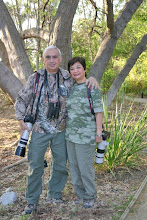Cynthia and I were sitting in our car peering through the gaps freed from raindrops resulting from the rhythmic left-right movement of the windshield wipers. Ahead a small dark figure contrasted from the virescent grass where it was searching for food, unmindful of the off and on downpour. "Barred Rail", I told my wife as I put down the binoculars.
We were at Hacienda Escudero. It was half past two in the afternoon. We were on our way home after enjoying the hospitality of our friend and fellow birder, Mela Balcazar, who took time off from her busy schedule to welcome us. Cynthia and I decided to visit Villa Escudero after having an almost heartbreaking stint at the University of the Philippines in Los Banos. Birds were uncharacteristically sparse particularly near the TREES hostel in Mt. Makiling. Thankfully a couple of cooperative Lesser Coucals and lots of Wood Sandpipers (early migrants?) at the buttonquail area saved the morning for us.
The primary birding reason for going to Villa Escudero is the resident Indigo-banded Kingfisher. With hopes of seeing that gorgeous bird we stationed ourselves by the river and waited. And waited. Soon the place began to swell with people lining up for the sumptuous buffet. Realizing that our sought-after kingfisher would not show up under such conditions, we joined the lunchtime crowd and enjoyed the luscious food, made even more pleasant by the excellent service of the staff.
After lunch the ominous claps of thunder further enforced the idea that we ought to give up on our kingfisher quest. At first I was perplexed. How can there be such repeated rolls of thunder on a warm, sunny day? But then gray clouds slowly dimmed the skies. That was when my wife and I decided to call it quits. Rain fell and we felt as gloomy as the weather, knowing birds would now be even harder to see. On the way out I thought of using the route via the Hacienda Escudero. Not only is it well paved, but we've seen some birds here during our previous visits.
It was on this road on that rainy afternoon that we encountered several species of the Rallidae family. I was driving very, very slow scanning the roadsides for birds. At that point any bird would have made us happy (well, maybe except the ubiquitous Eurasian Tree Sparrows). We were in this scanning mode when Cynthia suddenly yelled "Stop!" So I did. She pointed at a darkish bird perched atop a bush. At first I thought it was an oversized Common Moorhen. I looked at it through my binoculars. "W-w-wa-watercock!" I stuttered in excitement. I have seen this species only once before and it was at such a distance, the photograph that I got then left so much to the imagination. But this time, the bird just perched there unperturbed even when Cynthia and I got off the car, picked up our gear and shot away. Take note that it was drizzling all the time while we were taking advantage of this unusual opportunity.
Allow me to digress for a while. It's just that I think that "Watercock" is an unfortunate way of naming this bird. For one thing, the female is not referred to as "Waterhen" simply because there is already another species, also of the Rail family, having that name. Obviously the male of that species can never be referred to as Watercock as well. Quite confusing, really. What about the young ones of both species? Will they be called "Waterchicks"?
Back on the road again. Our slow driving and scanning the roadside shrubbery produced lots of Barred Rails as I mentioned earlier. There were also sightings of the tiny, and very quick, White-browed Crake. We didn't mind not photographing this little crake inasmuch as Cynthia already got a nice one at the Agripark earlier.
The biggest thrill, and frustration, however was by a species called Gallirallus striatus. Slaty-breasted Rail. I saw it furtively lurking by the grass-covered ditch. The chestnut crown and reddish beak was unmistakable. I just notched a new lifer! But it was still too far to be photographed. I inched our car nearer only to witness the rail slowly disappear from view as if swallowed by a verdant quicksand. We waited patiently for it to reappear but then the rain started to pour heavily again. I must say that this time we've been "de-railed" in our quest.
The rails we saw at the Hacienda Escudero road more than compensated for the disappointing scarcity of birds that we hoped to see that day.
Subscribe to:
Post Comments (Atom)








5 comments:
Love the rail and the crake shots!
Great birds and photos. Awesome sighting of the rail. It is great when the rails come out into the open. Wonderful shots, Bob!
Rails are fascinating but I find the ones out here are extra shy! More than one in the day would make it a very special birding trip. Hope you get your kingfisher another time.
Wow! Watercock! I felt the excitement when you wrote "w-w-wa-watercock!" hehe =) Congratulations!
several great birds. Thanks for sharing :)
Post a Comment